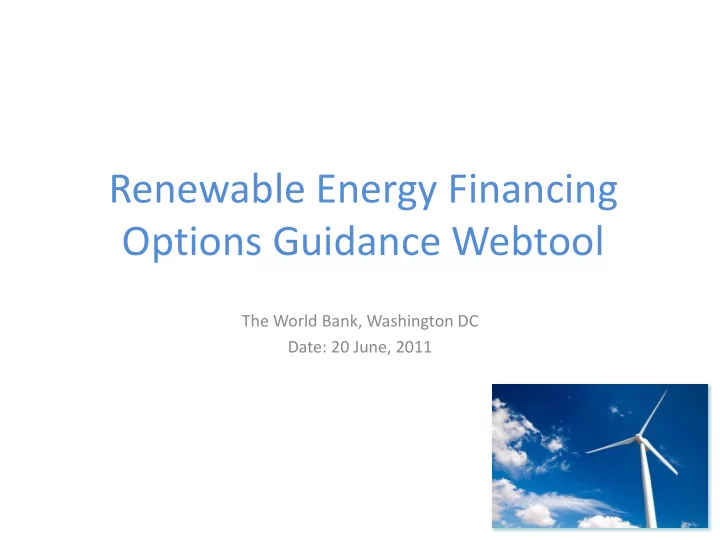

Renewable Energy Financing Options Guidance Webtool The World Bank, Washington DC Date: 20 June, 2011
Overview Renewable Energy Financing Options Guidance Webtool Financial Instrument Tool: Technical Specifications, Risks and Barrier Inputs. Financial Instrument Recommended
Component 1: Financial Instrument Recommendation Tool • Project details and applicable Lack of long term financing: RET technologies are characterised by high up-front capital costs and low ongoing operating costs, risks, and barriers to be input due to the nature of the technologies concerned. This implies a need for RET projects to be able to access long-term funding on by user a project finance basis — where the security for the loan comes Recommended Financial Instrument/s: from future project cashflows and where little or no up-front Project Loan collateral is required, although there will still be a need for a • In-built definitions for each share of the project to be funded from equity. Non or limited- Relevant Case Studies: recourse funding of this type allows RET projects to spread their entry Project Loan costs over the project lifetime, funding the high up-front cost Case study 1: Nepal – Power Development from the positive cashflows generated during operations. Project • Purpose: Based on user Further Reading: Financing Renewable Energy: Options for Developing input, the tool will Financing Instruments using SREP and Other Public Funds recommend financial instrument or instruments and associated case studies
Component 2: Range of Financial Instruments • Range of Financial Instruments Subordinated debt can take multiple forms. For the purposes of this webtool, subordinated debt is covered by the webtool considered to encompass all forms of mezzanine or quasi-equity finance, of which there are many variants. The key features these share in common are that repayment is subordinate to providers of senior debt • In-built definitions for each (hence the name), but that the financier does not obtain financial instrument, and links a shareholding and thus control of the project (although some forms of subordinated debt may be capable of to relevant case studies conversion to shares or, such as preferred shares, take the form of equity but with lesser or no rights of control). Further Reading: Financing Renewable Energy: Options for Developing Financing Instruments using SREP and Other Public Funds Relevant Case Studies: Case study 10: Macedonia Sustainable Energy Financing Facility
Webtool Application: Example • Contingent project development grants : RET projects, particularly when the Project details, Recommended Financial Instrument/s: technologies are new and unfamiliar, face significant risks of delays and barriers and risks 1. Contingent project development grants increased costs of project development due to technological problems and to entered by the user extended permitting and approvals procedures. Public agencies can provide 2. Revolving Fund funding to help defray these costs. If the funding is provided as a loan, which 3. Resource Insurance then converts to a grant if the project is successfully implemented, then • Based on user input, incentives are created for the developer to pursue rapid implementation of the Relevant Case Studies: financial instrument project. However, there are obvious concerns as to how the developer would Contingent Project Development Grants repay a loan if the project didn’t succeed as well as questions whether further will be recommended Case study 1: Philippines – Grid-connected solar PV-hydro hybrid incentives to reach implementation are required. An alternative mechanism is demonstration project actually the reverse, a contingent grant that transforms to a loan if the project is Case study 6 : Nepal Power Development Project successful. This allows development activities to proceed without the developer • Links to relevant taking on loans that they may default on if the project cannot be implemented financial instrument Revolving Fund for reasons outside their control, as well as providing a source of funds through Case study 1 : Thailand Energy Efficiency Revolving Fund loan repayments that can then be used for future project development grants. case studies will be Case Study 3: Central America – E+Co CAREC Mezzanine Finance Fund provided Further Reading: Resource Insurance Financing Renewable Energy: Options for Developing Financing Instruments Case study 8: Hungary-GeoFund Geological Risk Insurance using SREP and Other Public Funds Case study 3: Insurance for Renewables Relevant Case Studies: Case study 1: Philippines -- Grid-connected solar PV-hydro hybrid demonstration project Case study 6 : Nepal Power Development Project
Identifying Project Details, Risks and Barriers By selecting a financial tool listed in component 2, all Renewable Energy Financing Options Guidance Webtool applicable risks, barriers and project details will Financial Instrument Tool: Technical Specifications, Risks and Barrier Inputs. automatically be selected in component 1 Financial Instrument Recommended
Recommend
More recommend